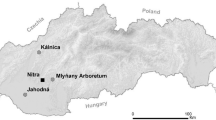Abstract
From field investigations and inoculations, Dothistroma pini, the pathogen of Dothistroma needle blight was found to overwinter as mycelium and unmaturcd acervuli in infected needles. The conidia were spreaded mainly by rain splash. The disease became widespread by transporting diseased seedlings and scions, conidia spread throughout the growing season, but mainly from May to July. The disease was found in both stand locations in each summer of investigation. The outbreak severity was serious in pure stands of susceptible pine and mixed stands with large components of susceptible pine, but slight in mixed stands of unsusceptible species with small components of susceptible hosts. The disease was less severe in pruned stands than in unpruned stands. The disease was most serious near the infection centre, indoor and outdoor tests, it was shown that Chlorothalonil smoke, Chlorothalonil spray and Thiram and Asomate sprays were effective control fungicides.
Similar content being viewed by others
References
1986. 14 (Supp), 50–55
1990, 18(2), 52–58
Giboson, I. A. S., Christensen, P. and Munga, F. M., First Observations in Kenya of a Foliage Disease of Pines Caused by Dothistroma pini Hulbary: Commonwealth Forestry Rev. 1964, 43, 31–48.
Gilmour, J. W., The Effect of Season on Infection of Pinus Radiata by Dothistroma pini. European Journal of Forest Pathology. 1981, 11: 265–269.
Peterson, G. W., Dothistroma Needle Blight of Austrian Pine: Infection and Control, Pl. Dis. Reptr. 1965, 49. 124–126
Peterson, G. W., Infection of Austrian and Poderosa Pines by Dothistroma pini in Eastern Nebraska. Phytopathology 1973, 63. 1060–1063
Peterson, G. W. Dothistroma Needle Blight of Pines. Forest Insect & Disease leaflet 143. U. S. Department of Agriculture Forest Service. 1982.
Van der Pas, J. B., Reduced Early Growth Rates of Pines Radiata Caused by Dothistroma pini. New Zealand Journal of Forestry Science. 1981, 11 (3): 210–220.
Whyte, A. G. D., Spraying Pine Plantation with Fungicides-the Managers Dilemma, Forest Ecology and Management. 1970, 1: 7–19. (abstract: RPP July 1980. Vol. 59, no. 7.)
Author information
Authors and Affiliations
Rights and permissions
About this article
Cite this article
Bingzhang, H., Xinglin, D., Chengyu, L. et al. The development pattern of Dothistroma needle blight and its control. J. Northeast For. Univ. 3, 48–53 (1992). https://doi.org/10.1007/BF02874887
Received:
Issue Date:
DOI: https://doi.org/10.1007/BF02874887




